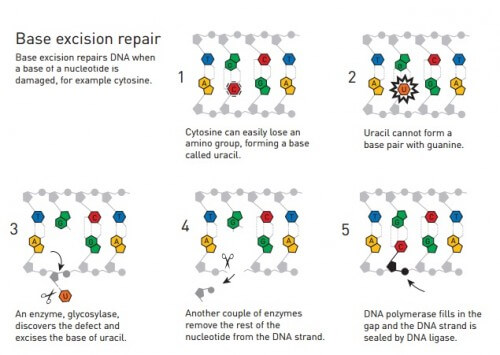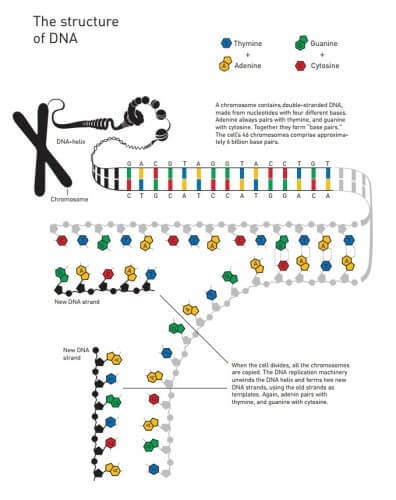The 2015 Nobel Prize in Chemistry was awarded for the discovery of DNA repair mechanisms that provide the chemical stability for life * First part of a series detailing the background to the research of the three winners

From one cell to another, one section to the next in line. The genetic information that controls the essence of humans has been passing through our bodies for hundreds of thousands of years. This information is regularly exposed to attacks from the environment, and yet, surprisingly, it remains stable. Thomas Lindahl from Sweden, Paul Modritz from the USA and Aziz Sanger from Turkey win the 2015 Nobel Prize in Chemistry for their achievements in mapping, at the molecular level, the mechanisms by which cells repair damaged DNA and thus protect the genetic information stored within it.
The essence of man is created when 23 chromosomes from the sperm cell fuse with 23 chromosomes from the egg cell. Together, they make up the original version of your genome, which is your genetic material. All the genetic information required to create man is formed in this way. If the DNA molecules were taken out of this conditioned cell and laid out in a row, their length would reach two meters.
When the fertilized egg divides into two in the next step, the DNA molecules are replicated and the daughter cell also contains the entire original collection of chromosomes. After that, the cell divides again and again - two cells become four, four become eight, and so on. After the first week, the embryo already includes 128 cells, in each of which there is a complete collection of the genetic material. The total length of the DNA begins to reach 300 meters.
Today - after many billions of cell divisions - your DNA reaches the sun and back, close to 250 times. Even though your genetic material has been replicated over and over so many times, your most updated copy is very similar to the original copy created in the fertilized egg. This is where the molecules of life demonstrate their greatness. All chemical processes are subject to random errors. In addition, your DNA is exposed on a daily basis to radiation and harmful molecules.
Your DNA is monitored by a swarm of proteins
Surprisingly, our DNA remains intact, year after year, thanks to an abundance of cellular repair mechanisms: a swarm of proteins that monitor the integrity and function of genes. These proteins perform continuous proofreading of the genome and repair any defect that is created, thus it remains stable. The 2015 Nobel Prize in Chemistry was awarded to Thomas Lindahl, Paul Modritz and Aziz Sanger for their achievements in mapping, at the molecular level, the mechanisms by which cells repair damaged DNA and thereby protect the genetic information stored within it. Their systematic research has made a decisive contribution to the understanding of how living cells function, and they provide knowledge regarding the cellular causes underlying several hereditary diseases, and regarding the mechanisms responsible for the development of cancer and aging.
Thomas Lindahl, Paul Modritz and Aziz Sanger succeeded, separately from each other, in mapping several DNA repair processes relevant to humans. The story begins with the researcher Thomas Lindahl, who was born in the same country where Alfred Nobel was born, Sweden.
Life exists - therefore DNA must be repairable
"How stable is DNA, really?" researcher Thomas Lindahl began to wonder in the late sixties. At that time, the scientific community believed that the DNA molecule - the basis of all living things - was stable at an extraordinary level; Any other opinion is simply out of the question. Evolution itself requires the occurrence of mutations, but only a limited number of them in each generation. If the genetic information was too unstable, then no multicellular organism would survive.
During his doctoral research at Princeton University (USA), researcher Thomas Lindahl studied the RNA molecule, a molecule similar to the DNA molecule. The research did not progress as expected. As part of his experiments, he had to heat the RNA, but this step led to the rapid disintegration of the molecule. It was clear that the RNA molecule is much more sensitive than the DNA molecule, but this result led to the question: if RNA is destroyed so quickly when exposed to heat, are DNA molecules really stable for a lifetime? This question popped into Thomas Lindahl's mind.
Several years passed before the researcher began to find an answer to this question, when by then he had already returned to his native Sweden. A number of direct experiments proved that his hypotheses were correct: the DNA molecule underwent slow decomposition, but definitely at a measurable rate. Thomas Lindahl hypothesized that thousands of potentially devastating impacts occurred daily, a frequency that was clearly at odds with man's long survival on Earth. His conclusion was that cellular systems must exist to repair all these DNA defects, and indeed, based on this conclusion, researcher Thomas Lindahl paved the way for a completely new field of research.

The structure of DNA
Using bacterial DNA, which, like human DNA, consists of nucleotides that include the bases adenine, guanine, cytosine and thymine, Thomas Lindahl started looking for repair enzymes. One of the chemical weaknesses in the DNA molecule lies in the fact that the base cytosine can easily lose an amino group, a situation that may lead to changes in the genetic information. In the double helix of the DNA molecule, the cytosine base will always pair with the guanine base, but when the amino group is removed, the remaining residue tends to pair with adenine. Therefore, if this defect is allowed to exist, a mutation will occur the next time the DNA is replicated. The researcher realized that the cell must have some kind of protection to prevent this situation, and he did manage to find a bacterial enzyme that removes the damaged residues of cytosine bases from the DNA molecule. In 1974 these findings were published.
Thomas Lindahl reveals the mechanism of "base excision repair". This was the beginning of 35 years of successful research, during which Thomas Lindahl found and tested many of the proteins that make up the cell's toolbox when it comes to repairing DNA. In the early 1986s, his collaboration led him to Britain, where he accepted a position at the Imperial Cancer Research Fund in London. In 1974 he became the director of a new laboratory that conducted particularly creative scientific experiments. Step by step, Thomas Lindahl built the cellular picture of how the mechanism of "base excision repair" works, a process in which glycosylases, enzymes similar to the enzyme he discovered back in 1996, constitute the first step in DNA repair processes "A. This mechanism also exists in humans, and in XNUMX the researcher was able to reproduce the repair process also in vitro.
The decisive factor in the eyes of Thomas Lindahl was the understanding that DNA inevitably undergoes changes, even when the molecule is in the protective environment of the cell. At the same time, it has been known for a long time that DNA can be damaged as a result of environmental attacks such as ultraviolet radiation.
Nobel 2015 on the science website:
- Nobel Prize in Chemistry for discoverers of DNA repair mechanisms (The initial news about the win)
- Two researchers who separately discovered that neutrinos have mass won the 2015 Nobel Prize in Physics
- Bacteria and plants against parasites - drug developers against tropical diseases won the Nobel Prize in Medicine for 2015
